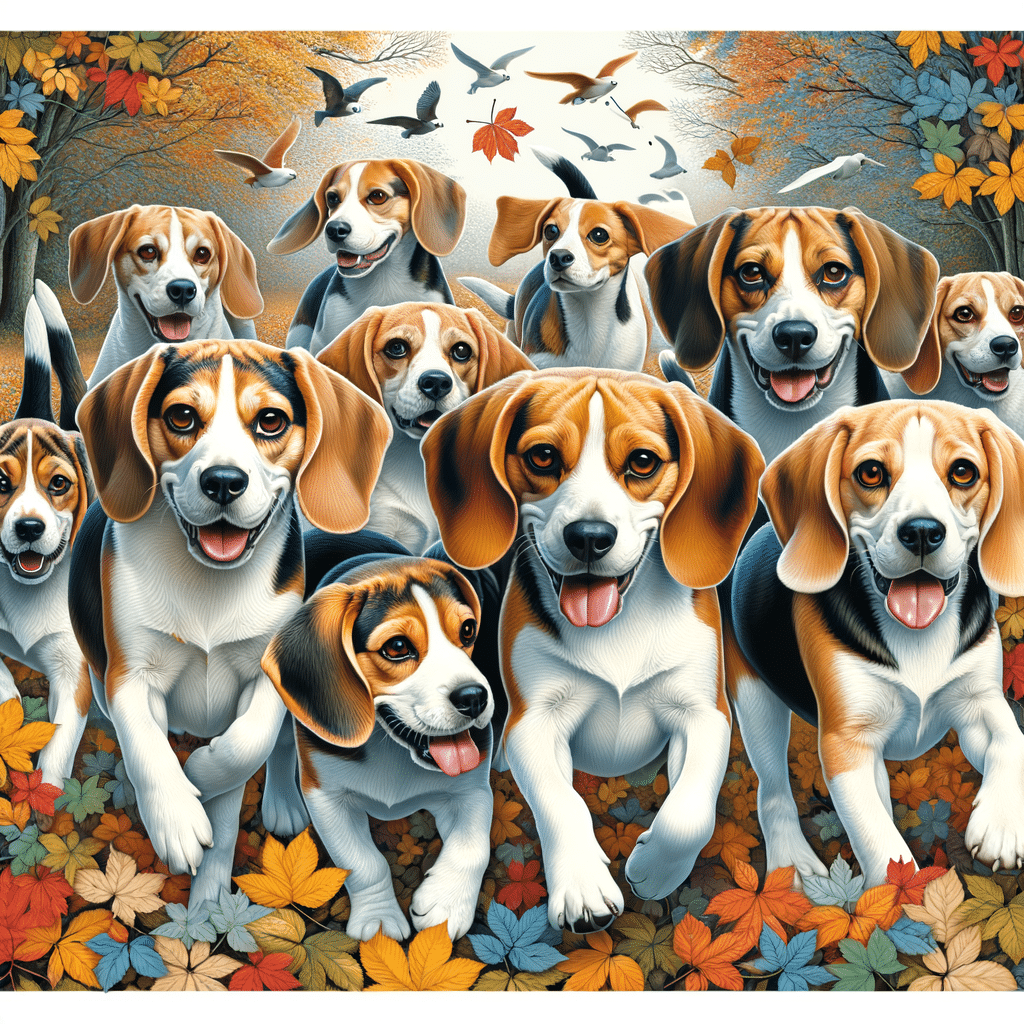The white beagle is a unique variation of the classic beagle, known for its loyal and intelligent nature. Historically bred for hunting due to their keen sense of smell and tracking ability, they come in various colors and patterns. The white beagle, in particular, can be striking, with a coat that is either pure white, sometimes the result of albinism, or white with lemon or colored markings. Despite its distinct appearance, the white beagle shares the same breed characteristics and temperament as its colored counterparts, making this dog breed a wonderful family pet and a pleasant companion.
In This Article
In This Article
- Breed Characteristics
- Health and Care
- Training and Socialization
- Choosing a Beagle
- Frequently Asked Questions
While the white beagle is not a separate breed, its coat color can make it stand out in a crowd of others. Understanding the white beagle involves recognizing that color does not impact a beagle’s personality or health, although albinism can bring specific health challenges such as skin and eye sensitivity. A prospective dog owner should also be aware that the popularity of unique coat colors can sometimes lead to less scrupulous breeding practices aimed at meeting demand rather than ensuring their health and well-being.
Highlights
- The white beagle possesses the standard breed's hunting dog lineage and friendly nature.
- Albinism in white beagles may necessitate specialized health and care considerations.
- The popularity of the white beagle's unique coat color demands careful attention to breeding practices.
Breed Characteristics
In exploring breed characteristics, it is essential to consider white beagles’ physical and behavioral traits. They exhibit a distinctive coat color and the lovable temperament often sought in companion dogs.
Physical Traits
White beagles typically stand at a height of 13-15 inches and weigh between 18-30 pounds, making them a suitable size for various living environments. Their coat is predominantly white, often accompanied by markings and ticks of other colors like lemon and tan. A beagle is rarely a solid white due to their hound origins and genetics. However, cases of albinism can result in a lack of pigmentation, rendering them pure white.
A notable physical feature of beagles is their ears, which are long and soft, hanging close to their cheeks. As for their coat texture, beagles possess a short coat that’s easy to groom. They are not hypoallergenic and shed moderately.
Coat color combinations typical features:
- White with tan and black (tricolor pattern)
- White with reddish brown, often with a ticking (spotted) pattern
- White with pale lemon or other lighter shade markings
Behavioral Traits
White beagle behavior is typified by intelligence, gentleness, and an affectionate nature. They are energetic and playful, which makes them an ideal fit for active families. Witht proper socialization and the help of a professional dog trainer, their good behavior can be protected. These steps are necessary to ensure desired behavior while avoiding destructive behavior, food aggression, and chewing behavior.
Thankfully, even without specialized dog training, beagles are generally gentle, tend not to show aggressive behavior, and have a friendly disposition that allows them to fit well in homes with or without children. Their temperament includes being active and companionable, with a keenness and attentiveness that makes them very aware of their surroundings. Despite their easy-going nature, they possess a fearless streak. Beagles are not just affectionate; they crave human company and are happiest when part of family activities.
- Temperament: Loyal, playful, and intelligent
- Activity Level: Energetic, requiring regular exercise
- Social Needs: High, enjoys being part of family activities
In summary, white beagles are small to medium-sized dogs that are as loving and energetic as they appear distinct. Their tricolor coats, intelligence, and affectionate behaviors make them well-loved family pets.
Health and Care
Like all breed variations, white beagles require specific attention to their health and care requirements to ensure a long and healthy life. This section outlines common health issues they may face and grooming and maintenance practices essential for their well-being: an adult beagle and beagle puppy.
Common Health Issues
Common health issues in white beagles include:
- Ear Infections: White beagles are prone to ear infections due to their long, floppy ears. Regular inspection and cleaning of the ears are crucial.
- Obesity: They are susceptible to weight gain. Proper diet and exercise are crucial to preventing obesity.
- Hypothyroidism: This condition can occur in beagles and may require lifelong treatment.
- Allergies: They can suffer from various allergies, which may require dietary adjustments or medication.
Their lifespan typically ranges from 12-15 years, and maintaining their health through regular veterinary care is a must to reach their total life expectancy.
Grooming and Maintenance
Grooming and maintenance for white beagles involve:
- Brushing: Weekly brushing is recommended to manage shedding and keep their coat healthy.
- Nail Trimming: Regular nail trimming is necessary to prevent discomfort and mobility issues.
- Bathing: Bathing is necessary, but care must be taken not to dry out their skin.
Proper care requires consistent routines that cover not only their coat but also their nails, teeth, and overall physical condition. Exercise should be part of their daily routine to help prevent obesity and keep them mentally stimulated. A suitable diet for their age, size, and activity level will support their general health.
Training and Socialization
Training a white beagle should start as early as possible due to their intelligence and propensity for curiosity. Beginning with basic commands and house training establishes a foundation for a well-behaved dog. Since beagles are pack animals, they thrive on companionship and can make excellent family pets.
Socialization is a pivotal part of a white beagle’s training regimen. Introducing them to various environments, people, and other animals helps mold them into adaptable and friendly pets. With proper introduction, this breed typically gets along well with other pets, including cats.
When socializing a beagle, it’s beneficial to:
- Visit dog parks for interaction with other dogs.
- Use agility courses to provide physical and mental stimulation.
- Incorporate play that encourages their natural agility.
Beagles require moderate to high levels of exercise to keep healthy and prevent boredom. They enjoy activities such as daily walks and fetch and mental stimulation exercises like tracking games and puzzles.
Regarding exercise needs, a minimum of 30 minutes to 1 hour of daily physical activity is recommended. Enriching their environment through play and training is critical to a white beagle’s physical and mental development. These dogs often excel in structured activities like obstacle courses and tracking due to their keen sense of smell and agility.
A well-socialized white beagle can be a charming addition for families looking for a loyal companion. Consistent training and socialization from a young age ensure these dogs grow friendly and well-adjusted.
Choosing a Beagle
When selecting a beagle, prospective owners should prioritize finding a reputable breeder or consider adoption from a shelter. Reputable breeders are often affiliated with the American Kennel Club (AKC), which provides a framework for breed standards. Beagles, recognized by the AKC as spirited scent hounds, should meet specific physical and temperament traits outlined by the AKC to be considered purebred beagles.
Breeder Selection Criteria
- Affiliation with AKC or similar authoritative bodies.
- Health clearances and vet checks for the puppies.
- Openness to questions about the breeding practices and lineage.
- Welfare-focused housing and care for their dogs.
Shelter Adoption
- Offers mixed breed beagles, which can have the benefit of hybrid vigor.
- It provides a chance to offer a home to a dog in need.
Health and Temperament
- Check for a comprehensive health guarantee.
- Look for signs of a well-socialized puppy: friendly, playful, and not overly fearful.
Breed Standards and Purebred Qualities
- Confirm adherence to breed standards if choosing a purebred, including size and coloring.
- A purebred beagle should exhibit traits of a loyal companion, such as intelligence and friendliness.
Mixed breeds can also make excellent companions, often bringing a unique combination of traits from different breeds. Whether choosing a purebred or mixed beagle, the dog should align with the prospective owner’s lifestyle, energy level, and maintenance expectations.
By thoroughly evaluating breeders or shelters, ensuring healthy and temperamentally sound choices, and understanding the breed standards and characteristics, one can make an informed decision when bringing home a new beagle companion.
Frequently Asked Questions
This section addresses common inquiries about white beagles, providing insights into costs, characteristics, breeding, health concerns, and color patterns of this particular variation of the beagle breed.
How much does a white beagle typically cost?
The price of a beagle puppy can vary widely, but purchasers should expect to pay between $400 to $1200 depending on the breeder’s reputation, the dog’s lineage, and regional factors. Prices may rise for beagles that have a rare coloring like white.
What are the typical characteristics of a beagle that’s predominantly white?
Predominantly white beagles often have light yellow (lemon) patches, typically on their ears and back. While puppies may appear almost white at birth, the lemon color generally intensifies as they age, resulting in a light yellow tint rather than pure white.
How can I find reputable breeders offering white beagle puppies?
One should search for breeders registered with national kennel clubs or beagle-specific breed associations to find reputable breeders. Reading reviews, asking for referrals, and seeing the breeder in person are also advisable to ensure they use ethical breeding practices.
Are there any health concerns associated explicitly with white beagles?
White beagles do not have specific health issues solely based on their color, but all beagles are prone to certain conditions like hip dysplasia, epilepsy, and hypothyroidism. A veterinarian should monitor any beagle for signs of genetic health problems.
What is the likelihood of finding a completely white beagle?
An all-white beagle is rare and does not conform to the breed standard, so it is more difficult to find. Beagles described as white typically have some color markings, such as tan, yellow, or light gray. A white beagle likely results from selective breeding or a rare genetic anomaly.
How does the black and white coloration in beagles like Snoopy occur?
The black and white coloration seen in beagles, such as the fictional character Snoopy, occurs because of the genetics behind the breed’s coat patterns, where the black saddle marking and white base are commonly associated with the well-known tricolor beagles.






